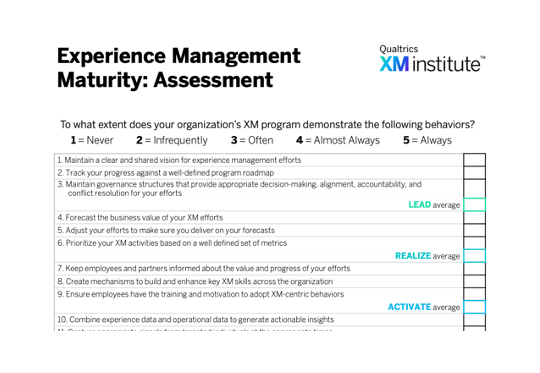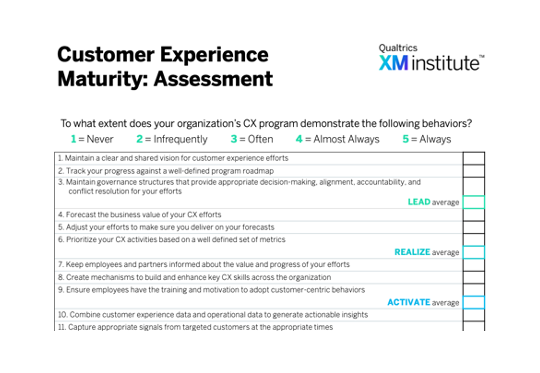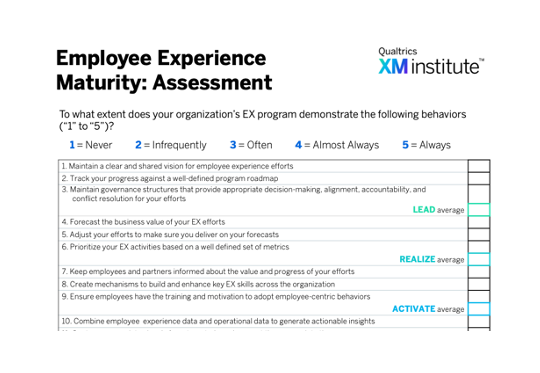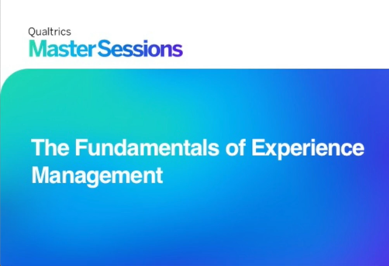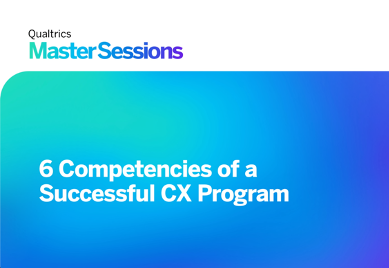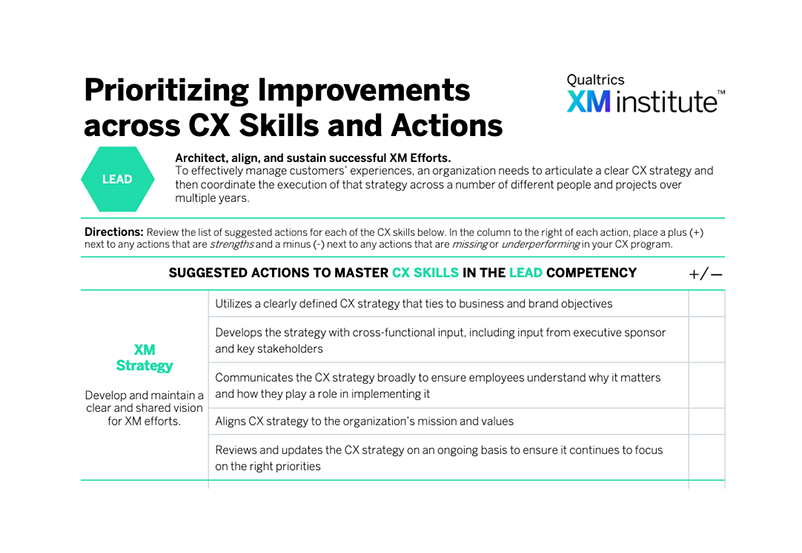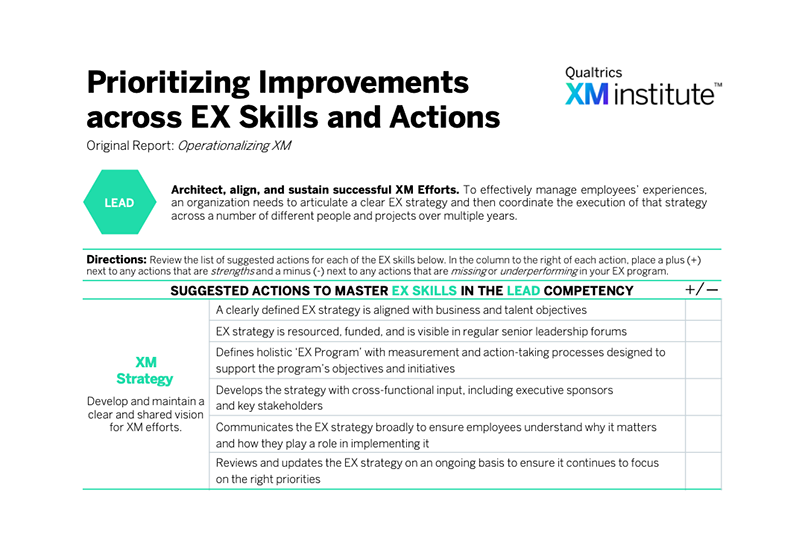Use this Launchpad as a starting point to understand how organizations can go about building their Experience Management capabilities by adopting the XM Operating Framework. Then explore the key resources included at the bottom of the page to expand your knowledge of this XM topic.
The Fundamentals
Experience Management (XM) is defined as:
The discipline of using both experience data (X-data) and operational data (O-data) to measure and improve the four core experiences of business: customer, employee, product, and brand.
To establish XM as a discipline, organizations need to adopt the XM Operating Framework. The XM Operating Framework is a blueprint that lays out how organizations should go about mastering Experience Management. It provides companies with a curriculum they can follow to build XM knowledge and expertise across their business. This Framework is made up of three elements:
Technology
Technology refers to the technology platform that empowers an organization to collect, understand, and take action on insights and data. A powerful XM platform is an essential component of any XM effort as it allows the company to capture, analyze, and distribute a constant flow of insights to the relevant people and processes. Without such a platform, companies won’t be able to scale Experience Management capabilities and practices across the entire business.
Competency
Competency refers to the skills and actions that establish XM as a discipline. At the end of the day, to realize value from Experience Management, companies are going to have to alter the way they operate in a number of different ways – from how they collect and use insights, to how they design experiences, to how they engage leaders and employees in their change efforts. This element is made up of six XM Competencies: Lead, Realize, Activate, Enlighten, Respond, and Disrupt.
Culture
Culture refers to the mindsets and beliefs that encourage and nurture XM-centric behaviors across the organization. A company’s culture will either accelerate or inhibit the spread of XM-centric behaviors and practices. So, if XM is going to thrive across the business, organizations must create an environment that fosters XM-centric mindsets and behaviors in its leaders and employees.
While all three of these elements are crucial to XM success, the place where organizations should concentrate most of their efforts is on the Competency element. A good way to think about the relationship between these three elements is that organizations go about establishing XM as a discipline by mastering the Competencies, and these Competencies are enabled by their Technology and they’re nurtured by their company’s Culture.
To master this Competency component, an organization should focus on building six specific XM Competencies, each of which is developed through a set of skills – three or four Skills under each Competency:
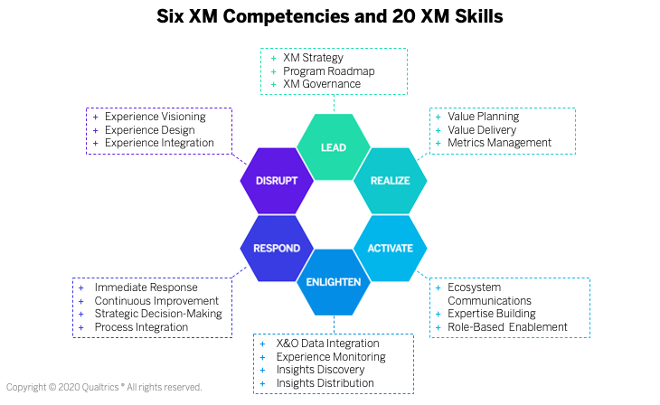
Here’s a brief overview of each of these XM Competencies:
LEAD
To effectively manage the experiences of suppliers, customers, employees, and partners, an organization needs to articulate a clear XM strategy and then coordinate the execution of that strategy across a number of different people and projects over multiple years. This Competency is about architecting, aligning, and sustaining successful XM efforts, and the Skills associated with it are XM Strategy, Program Roadmap, and XM Governance.
REALIZE
For XM efforts to have a lasting positive impact, they need to generate strategic and financial value for the organization. This Competency is about identifying and tracking the right metrics to ensure XM efforts achieve well-defined business objectives, and the Skills associated with it are Value Planning, Value Delivery, and Metrics Management.
ACTIVATE
People tend to gravitate towards the status quo, so a successful XM program must overcome people’s inertia and their natural resistance to change. This Competency is about making sure that the organization has the appropriate skills, support, and motivation to achieve desired XM results, and the Skills associated with it are Ecosystem Communications, Expertise Building, and Role-Based Enablement.
ENLIGHTEN
To improve the experiences it delivers, an organization must be capable of collecting and processing a constant flow of X-data and O-data, and then transforming all that data into useful information. This Competency is about capturing, analyzing, and distributing actionable insights, and the Skills associated with it are X&O Data Integration, Experience Monitoring, Insights Discovery, and Insights Distribution.
RESPOND
Gathering and disseminating insights is all well and good, but ultimately, value is only generated when an organization acts on what it learns. This Competency is about building organizational mechanisms to continuously take action based on insights, and the Skills associated with it are Immediate Response, Continuous Improvement, Strategic Decision-Making, and Process Integration.
DISRUPT
While finding and fixing problems is necessary, just responding to explicit issues is not sufficient to capture people’s hearts and minds. This Competency is about identifying and creating experiences that differentiate the organization from its competitors, and the Skills associated with it are Experience Visioning, Experience Design, and Experience Integration.
Tips for Taking Action
So how should a company go about building their XM capabilities across the XM Operating Framework? Here are some tips for taking action:
Assess your XM maturity level
Organizations don’t become XM-centric overnight – they evolve through five stages of maturity as they gradually master the six Competencies and 20 Skills. To understand the current state of your program and develop plans for making progress towards your goals, first assess the maturity of your XM, CX, or EX program.
Work on all six Competencies
While organizations will focus on and mature the six Competencies at different times and at different paces, these Competencies work as a system. You can’t master one and then move on to the next. You need to work on improving all six.
Build four cultural attributes
To build a culture where XM-centric mindsets and behaviors are ingrained in all leaders and employees across the business, focus on cultivating four attributes: Purpose-Led, Human-Centric, Change-Minded, and Evidence-based.
Invest in a robust XM platform
As your XM program matures, it will naturally begin collecting more experience data, combining it with operational data, applying more advanced analytics, and distributing more customized insights to people around the business. It’s therefore critical to have an XM platform that’s enterprise-grade, flexible and extensible, powerful and easy, infused with expert advice, and action-oriented.
Look for opportunities to diffuse XM
Your XM efforts will falter if you over-invest in maturing only a few, isolated experiences or if you spread your resources too thinly across too many different areas. Instead, mature and diffuse your XM capabilities in tandem. As you mature your XM Competencies and Skills, actively look for opportunities to apply those capabilities to more and more activities and experiences across the organization.



